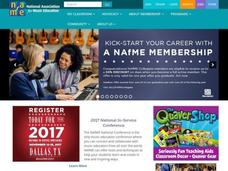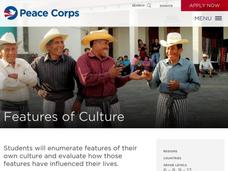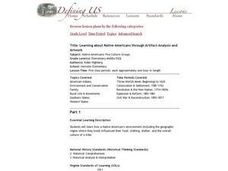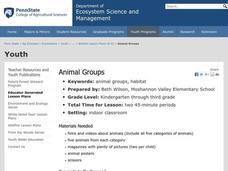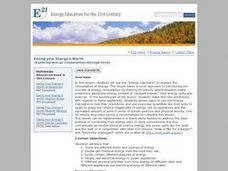Curated OER
What Would You Take to Sea? Instructions for Teachers
Pupils, who are teachers, discover the hazards facing sailors hundreds of years ago as they prepare a lesson to use in their classroom. They examine what each group of students will investigate, and how the findings will be discussed.
Curated OER
Microwave Introduction
Students take true and false pretest, and explore and practice basic principles of microwave cooking and how to use and care for it properly while preparing foods. Students watch teacher demonstration and then prepare their own bags of...
Curated OER
Strawberry DNA extraction
Students study the basic function of DNA and then extract it from strawberries. In this DNA extraction instructional activity students examine DNA and see why the extraction of it is so important to scientists.
Curated OER
Life Cycles
Using computers, Students work in small groups and progress through the roles of Explorer, Researcher, Designer, and Evaluator as they study the life cycle of plants, insects, butterflies and frogs.
Curated OER
Nutrition for Kids...and Astronauts
Second graders, in grades 2 and 5, cooperate to create a PowerPoint presentation about nutrition and food. They have a feast culminating the project and invite parents.
Curated OER
Fit Kid
Students practice and perform the song "Fit Kid" while learning the basics of motion and music and dynamics in this elementary-level lesson for the General Music classroom. The lesson emphasizes proper exercise and diet for a healthy life.
Curated OER
Carnivorous Plants
Pupils examine how carnivorous plants get their nutrients from animals. In this food web lesson plan students examine how the plants attract their prey and are given many onilne sources to research.
Curated OER
Free Enterprise--Product Cost
Pupils apply basic math skills in computing a product cost.
Curated OER
Dietary Fiber
Students examine the different types of fiber and their benefits. For this investigative lesson students find good sources of fiber in different foods.
Curated OER
Food Classification
Students are introduced to classification and some of the difficulties surrounding classification and how classification systems need to be able to adapt and how they may need to be changed when new information is discovered. They...
Curated OER
Nutrition in Me!
Third graders explain the basic healthy eating and physical activity concepts. In this healthy lifestyles instructional activity, 3rd graders describe two main components of a healthy lifestyle, demonstrate two different types of...
Curated OER
Prosperity and Challenges
Learners watch a slideshow about the technological advances in agriculture. After viewing, they complete an index card about one aspect of the slideshow. In groups, they create a cause and effect timeline in which they identify specific...
Curated OER
Dinosaurs
Learners are introduced to the various types of dinosaurs and write in their journals about their favorite one. After listening to a story and watching a filmstrip, they color a few pages in their Dinosaur Friends Book. They also examine...
Curated OER
Features of Culture
Students examine features of cultures. In this cultural diversity instructional activity, students explore 5 features of culture as they compare their cultural traditions to the traditions in other cultural groups.
Curated OER
Counting on Good Health
First graders engage in fun activities in order to understand the food pyramid and how to make healthy nutritional choices. The lesson plan is used in order to help students make healthy lifestyle choices.
Curated OER
Learning about Native Americans through Artifact Analysis and Artwork
Sixth graders assess how a Native American's environment and the geographic region where they lived influenced their food, clothing, shelter and the overall culture of a tribe. They study the impact of conservation, family, rural life,...
Curated OER
Animal Groups
Students explore animal groups. In this animal science lesson, students use pictures from magazines and classify the animals into five categories. Students share why they categorized the animals the way they did.
Curated OER
Sometimes and All the Time Foods
Students recognize a wide variety of fruit and have a greater understanding about the importance of fruit in their diet, and determine that some fruits' skins are edible and others are not.
Curated OER
Math, Chemistry, and Food
Students explore the effects of chemical reactions when cooking. Using the Internet, they research enzymes and then mix jello. They examine their results and test enzyme activity by adding pineapple to the jello. Finally, they test...
Curated OER
Adding & Subtracting (Combining) Integers
Maintain a positive atmosphere in your math class with this fun lesson on adding and subtracting integers. After first explaining the rules for combining positive and negative numbers, this resource uses a comic strip...
Overcoming Obstacles
Clarifying Values
Encourage thoughtful decision making with a instructional activity that highlights the importance of values. Scholars take part in a grand conversation, listen to stories, and make decisions based on their personal values.
Virginia Department of Education
Photosynthesis and Cellular Respiration
Provide high schoolers with their own indoor gardens! Emerging scientists discuss the process of photosynthesis and germinate seeds before growing plants in multiple lighting conditions. The hands-on application allows...
Curated OER
Stats on Reduced-Fat
Middle schoolers demonstrate an understanding of the Five-Number Summary and Box-Plots after analyzing data from nutrition labels, forming a hypothesis and supporting it. They decide if there is a significant difference between reduced...
Curated OER
Eating your Energy's Worth
Students calculate the amount of electrical energy used in a week in food units. They create ways to reduce energy use. Students discuss the different forms and sources of energy. They discuss how people use electrical energy to power...





